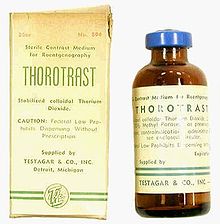
Back ثوروتراست Arabic Thorotrast Danish Thorotrast German Thorotrast French Torotrasto Italian トロトラスト Japanese Thorotrast NB Thorotrast Polish Thorotrast Vietnamese

Thorotrast is a suspension containing particles of the radioactive compound thorium dioxide, ThO2; it was used as a radiocontrast agent in clinical radiography in the 1930s to 1950s. It is no longer used clinically.
Thorium compounds produce excellent images because of thorium's high opacity to X-rays (it has a high cross section for absorption). However, thorium is retained in the body, and it is radioactive, emitting harmful alpha radiation as it decays. Because the suspension offered high image quality and had virtually no immediate side-effects compared to the alternatives available at the time, Thorotrast became widely used after its introduction in 1931. António Egas Moniz contributed to its development.[1] About 2 to 10 million patients worldwide have been treated with Thorotrast. However, today it has shown to increase risk of certain cancers, such as cholangiocarcinomas, angiosarcomas and hepatocellular carcinoma, and fibrosis of the liver.
- ^ Tondreau, R. (1985). "Egas Moniz 1874–1955". Radiographics. 5 (6): 994–997. doi:10.1148/radiographics.5.6.3916824. PMID 3916824.